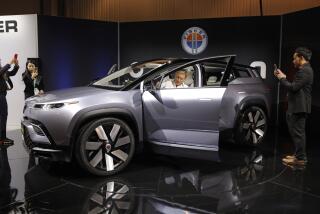How I Made It: Derek Jenkins, design director at Mazda North America
The gig: As director for design at Mazda North America in Irvine, Derek Jenkins leads the design direction of Mazda’s current and future vehicle lineup. Jenkins, 44, has shaped the look of the brand’s top-selling models and is the pen behind the upcoming refresh of the MX-5 Miata.
Riding the wave: Jenkins grew up in Huntington Beach, surrounded by the surf and car cultures. “I was one of those grom kids who surfed as much as humanly possible,” Jenkins recalled. When he wasn’t in the water, he was soaking up the world of cars.”I consider growing up in that area pretty influential, especially in the 1980s but even so today,” Jenkins said. “There’s just a ton of car culture around you.”
Dad and the VWs: His father was a fan of old air-cooled Volkswagens and was among the first in Southern California to work on Baja Bugs — VW Beetles refitted with beefy tires, suspensions and body kits for off-road duty. Jenkins’ first vehicle was a VW Thing, which he bought when he was barely 14. “I was fanatical about that car; I restored it, though looking back on it now I think my craftsmanship was pretty questionable,” Jenkins quipped.
Pasadena beckons: A visit to Pasadena’s renowned Art Center College of Design when he was 16 “basically sealed the deal,” Jenkins said. Up until that point he had no concept of what went into the car-design process. “The notion of car design, even for enthusiasts, was never publicized. People just didn’t know about it,” he said. “Once I found out about it, I said, ‘This is what I’m going to do.’”
Studying the road: At Art Center, Jenkins studied under car designers with vast experience in the industry and alongside classmates who now lead design studios at automakers including General Motors, Hyundai and Bugatti. “I consider myself extremely lucky to grow up in California around this car-centric world,” he said. “And the Art Center, which exists for the same reason. It’s a huge part of how I got into this industry.”
Off to Germany: His fascination with VWs and Porsches helped Jenkins win a scholarship from Porsche and an internship at Porsche’s R&D center in Weissach, Germany. An internship at Audi turned into a full-time job after he graduated in 1993. During his time at Audi, Jenkins worked under J Mays and Freeman Thomas, notable American designers (and fellow Art Center grads) best known for the New Beetle. Jenkins got a chance to see the evolution of a car’s design and watch its creators weave a narrative for the new model, exploring what it would mean to both Volkswagen and Beetle buyers alike.
Curve ahead: Jenkins’ first project as an Audi employee was the A2, a small hatchback many consider ahead of its time for its radical approach to weight savings and efficiency. “It was also a complete failure at the time,” he laughed. “People just weren’t ready to pay a premium on a small car, regardless of the technology or how smart it was.” After the A2, he worked on earlier generations of Audi’s A4 and A8 sedans before moving back to Simi Valley to be an assistant design chief for Audi.
Overdrive: In 2000, he became design chief for VW’s North American operations. In 2009, Mazda came calling. “At that point, the company was poised for repositioning,” Jenkins said of Mazda. The automaker had just promoted Ikuo Maeda to be its global design chief; Jenkins and his new boss worked in tandem. “The timing was perfect to come in, set down new guidelines and new thinking about design,” he said. His first project was the CX-5 compact crossover, followed by the 6 midsize sedan and the 3 compact sedan and hatchback.
Miata modification: Then came his biggest challenge, the fourth-generation MX-5 Miata two-seater, due on sale in 2015. “It’s really a once-in-a-career opportunity to do something like that,” Jenkins said of the car that resurrected the small roadster segment when it debuted in 1989. “People are either going to love you or hate you or some combination of both for what you’re going to do to the car.” Because he had owned a Miata and grew up loving what the car was, “I came to that project with a pretty strong conviction that we had to make a pretty big change to it. We had to do something that would get people to notice,” Jenkins said. The 2016 Miata is smaller and lighter than its predecessor and returns the car to its more simple roots.
Designs in the fast lane: So what else on the road gets a designer like Jenkins excited? Aside from the current Porsche 911, he has a particular respect for BMW’s new i3 and i8 cars. “I wouldn’t call them beautiful but I would call them very forward designs,” he said. “I know how hard it is to do something innovative and those cars just blow everything out of the water.”
In the garage: Jenkins’ rides include a Mazda CX-9 crossover for family duties — he’s married, with two sons — and whatever Mazda company car he has at the time. There’s also his beloved Myers Manx, a raucous street-legal dune buggy he built by hand. His roster of former cars is long, and included a beloved 1997 Porsche 911 S (“Totally bummed I sold that,” he said.), a Lamborghini Espada and a Lotus Esprit.
Long commute: Despite working at Mazda’s North American headquarters in Irvine, Jenkins lives in Malibu. “If you like cars and motorcycles — it doesn’t matter what genre — there’s literally no place on Earth like it there. Living in L.A., you really don’t have to try to stay on top of things, you’re just immersed in it already.”
david.undercoffler@latimes.com
Twitter: @LATimes_driven







